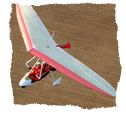After a quick bit of algebra, we came up with the following formulae:
Mags off + leaning over and checking fuel = Accidentally knocking the switches to the 'off' position!
There are merits of having two tanks. We have benefited several times when on a flying holiday and we were running low on juice.
It's fairly easy to detach and carry a single tank to refuel. Having to monitor your fuel situation and change tanks in mid-flight is unfortunately one of the downsides, however.
Several curses later and standing in the middle of a beet field, we discussed our escape strategy. I would tramp to each corner of the field and make a judgement on which was the best surface to get airbourne from.
The Western end looked like a winner, until we canned the idea because it sloped a bit too much uphill and would need too much plucking.
The Southern end looked fairly good and that was where I had landed. We discussed and estimated that we needed a minimum of 70 metres into wind to get airbourne, with an extra few metres "just in case".
Unfortunately, the escape options in the event of a problem were a bit thin on the ground. It was a take-off towards the tall trees 4 fields away that I had skimmed over on approach; and it was surrounded by recently ploughed ground. It was directly into wind though. Yes.. I had landed 'slighty' downwind..
We made an executive decision and chose the path that the tractor appeared to have been driven along the last time the field was ploughed and harvested.
It was fairly straight, ran parallel to my track on the Southern boundary, and was about 10 metres away from the hedge which was preferable
We grinned and were sure we could pluck a suitable track to use for takeoff.
Thankfully, as it turned out, only the central section between where the tyres had not flattened needed weeding and extracting, so it made the job easier!
30 minutes of gardening in 80% humidity later, we finally had our DIY runway prepared!
"So who's going first ?"
G-VR volunteered and we taxiied up the end of our take-off run, turning against the hedge to give maximum takeoff distance.
I wished him "Good luck!" and watched him power away! Vrrrroooom - The runway vanished surprisingly quickly as he raced down it and got airbourne about 5 metres before our estimated takeoff point.
I always knew those precision take-offs and landing during training would pay dividends in the end!
I taxiied up to the same point and took a gulp.I gave the 912 engine a good foot on the juice, doing several Magneto drops to be sure everything sounded right. It's strange how you listen more intently when you have to be especially lucky!
Foot to the floor, I throttled down our runway and to my relief got airbourne in an even shorter distance.
Mission Accomplished! Click on the picture below to see a larger version.
The Field from the Air
N.B. The field had not been farmed for about 2-3 years so we didn't pluck any 'live' crops.





